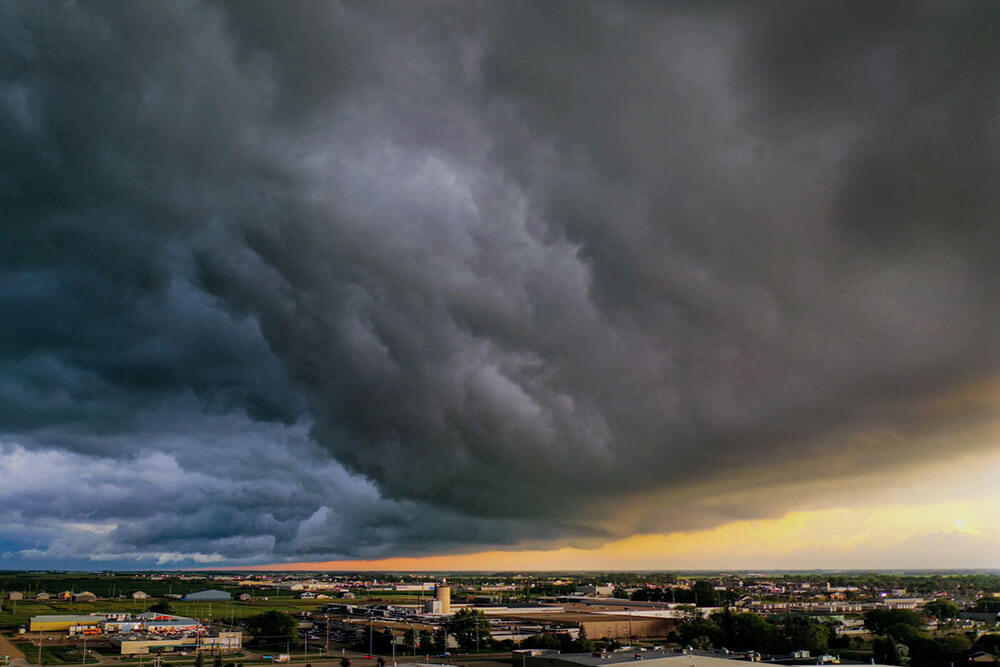What happens when a mega-force wind gets into some mixed martial arts-style action with a thunderstorm? You get a tornado. And Canada happens to get the second highest number of tornadoes after the U.S., with the majority happening in the Prairies and Ontario.
If you live in a tornado-prone region, you should know the signs of an oncoming tornado and what to do before, during and after. You should also understand how tornado damage is covered under your home and auto insurance so you’re prepared if there’s any damage in the aftermath.
Signs of a tornado How to prepare for a tornado How to protect your home and vehicle from tornado damage During the tornado: Stay low, stay safe After the tornado What happens if a tornado destroys my house? Does home insurance cover tornado damage? What if a tornado causes water to enter your home? Does car insurance cover tornado damage?
Signs of a tornado
- Sky is unusually dark, often greenish
- Hail or heavy rain, followed by extreme calm
- Large, dark low-lying cloud
- Loud, roaring sound
How to prepare for a tornado
- Always keep an
emergency kit and anemergency evacuation plan in your home. You never know when it could come in handy. - Keep track of the tornado’s location by listening to the news. In areas where tornadoes are more common, there may be an outdoor siren warning system.
- Get organized ahead of time by taking photos or video of your home contents, as well as photos of important documents (passport, birth certificate, social insurance card, etc.) Keep originals safe at home with a fire and waterproof safe or keep them offsite in a safe deposit box.
- In case you need to evacuate your home, establish a meeting place where your family or housemates can meet.
How to protect your home and vehicle from tornado damage
While it’s impossible to predict the extent of damage a tornado can make, you can proactively ensure that the exterior of your home is protected. Here are a few items that you should address before a storm occurs.
- Roofs. Check for any loose shingles and secure them in place. Ensure ridge vents are strong enough to resist high winds and rain.
- Porches and carports. Double check to make sure supporting posts are securely connected to the foundation and overhang.
- Windows. If you live in a storm-prone area, installing storm shutters might be a good idea.
- Doors. To ensure that your doors can withstand heavy winds, reinforcing with a deadbolt will help the door stay shut during a storm.
- Garage doors. Having a pressure impact-rated garage door will help keep everything in the garage secure.
- Outdoor objects. If you know a storm is coming and if it’s safe to do so, store away things like lawn furniture and patio umbrellas that could become dangerous if flying in the air.
- Landscape. Proactively trim branches and shrubs and remove any yard debris. If you frequently get high winds, converting your driveway to asphalt from gravel will minimize loose debris, which is less destructive when blown around.
During the tornado: Stay low, stay safe
- The safest place to be is in a basement, storm cellar or an interior room/hallway without windows on the lowest floor.
- Stay in your safe area until the storm has safely passed.
- Avoid windows.
- Avoid being in a vehicle or motor home – they provide little to no protection from tornadoes.
- If you’re outside and can’t get indoors, lie flat in a depressed part of the ground or low ground until the storm passes.
After the tornado
- Continue to monitor news broadcasts or social media for emergency information.
- Avoid entering damaged structures. Wear sturdy shoes or boots when walking in areas with debris.
- Stay away from downed power lines and report any electrical hazards to the power company.
- Cooperate fully with authorities and public safety officials.
Once it’s safe (check with local officials), check to see if there’s been any damage to your home or vehicle. Do your best to protect your property for any more damage, like moving furniture away from a broken window. Here are some common questions about how you’re covered.
What happens if a tornado destroys my house?
If your home gets destroyed by a tornado, you’ll most likely be in shock. It’s devastating to see your home in complete ruins. First make sure you and your family are safe. Do not enter your home unless cleared by officials as there could be gas leaks or electrical damage. Then as soon as you can, you’ll want to get in touch with your insurer to start the home insurance claim process.
Does home insurance cover tornado damage?
Yes, most home insurance policies include coverage for wind or windstorm damage. This means you’ll have protection from potential tornados, since they fall under the windstorm category. So, if your shutters fly off, your garage gets damaged, or if any of your personal belongings get blown away, your home insurance policy will help recover the costs. But it’s a good reminder to double check your home insurance policy to know what you’re covered for and what you’re not.
What if a tornado causes water to enter your home?
For example, let’s say the tornado caused your roof to blow off which resulted in rain pooling in your living room. In a situation like this, you should have coverage under your home insurance policy since the damage was the direct result of an insured event (the tornado). But, most home insurance policies don’t include coverage for direct flooding from
